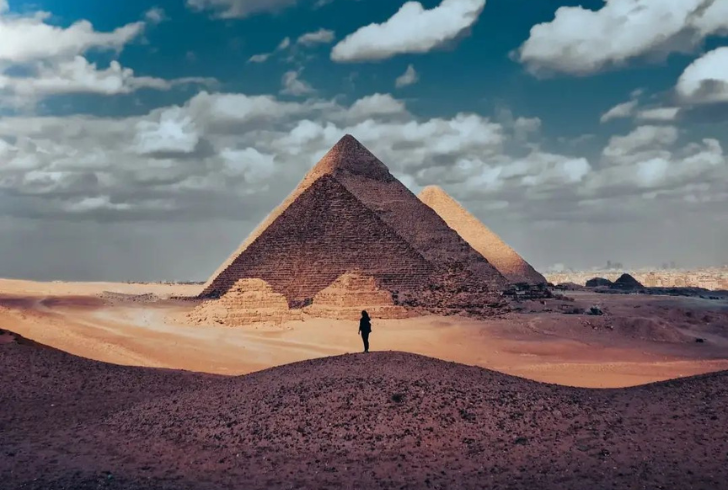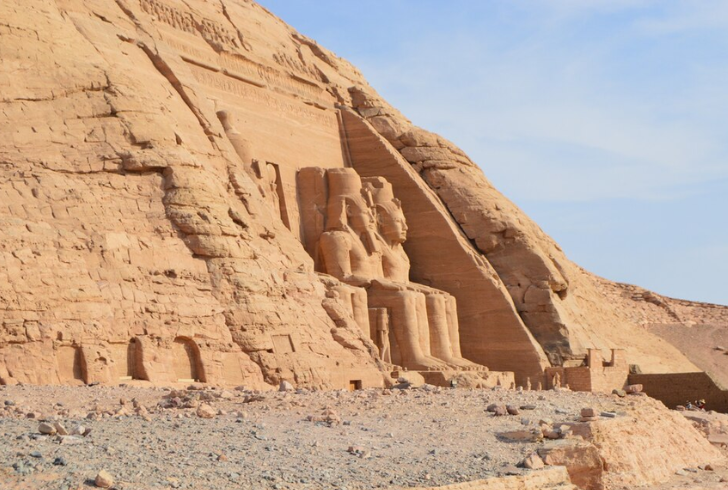In the annals of history, a tale whispers about the renowned French General Napoleon Bonaparte, whose mysterious night inside the Great Pyramid of Giza sparks intrigue. The legend suggests that after this experience, Napoleon, usually known for his bravado, emerged pale and shaken, choosing silence for 23 years.
On his deathbed, he briefly shared, "Oh, what’s the use? You’d never believe me." While the authenticity of this story remains uncertain, it encapsulates the timeless allure and romance surrounding the Egyptian pyramids. These ancient structures, standing for over 4,000 years, have captivated the imaginations of travelers, artists, and scholars, serving as silent witnesses to a flourishing civilization along the Nile.
The Pyramids: An Architectural Tapestry Unveiled

Pixabay | henryleester | Beyond Giza, over 180 pyramids stand across Egypt, built over 2 millennia.
Venturing beyond the iconic Pyramids of Giza, a vast tapestry of over 180 pyramids spans Egypt, constructed over a span of 2,000 years. The origin of pyramid construction traces back to the 27th Century B.C.E during the Old Kingdom period.
Before this era, kings found their resting places in low, rectangular mastabas. Mastabas, solid structures with small nooks or chapels, housed the deceased, along with essential items for the afterlife. Even as the transition to pyramids unfolded, mastabas endured as burial sites for officials and citizens.
The Stepped Innovation
The genesis of pyramid architecture is marked by the Stepped Pyramid at Saqqara, commissioned by Pharaoh Djoser around 2650 B.C.E. Designed by the polymath Imhotep, this architectural marvel began as a mastaba and evolved into a six-tiered structure, showcasing early experiments with stone construction.
The extensive underground complex, adorned with intricate reliefs, unveils Djoser's quest for architectural grandeur. The motives behind this departure from tradition remain shrouded in mystery—was it a demonstration of power, a spiritual ascent, or a representation of cosmic elements?
Sneferu's Trials and Triumphs
The pyramidal evolution faced setbacks with Pharaoh Sneferu's attempts at Meidum and Dahshur. The Meidum Pyramid, transitioning from a stepped to a smooth-sided structure, suffered architectural flaws, resulting in a halted construction. Undeterred, Sneferu's endeavors at Dahshur led to the "Bent Pyramid," characterized by a unique angle and well-preserved casing stones. The subsequent success of the Red Pyramid marked a turning point, setting the blueprint for the Great Pyramid.
Khufu's Architectural Marvel

Instagram | voyagetellers | Erected by Sneferu's son, Pharaoh Khufu is the largest pyramid ever built.
Enter the grandeur of the Great Pyramid of Giza, erected by Sneferu's son, Pharaoh Khufu, around 2570 B.C.E. Distinguished as the largest pyramid, its uniqueness extends to the majority of inner spaces housed within the structure.
Unlike its predecessors and successors, the Great Pyramid's Subterranean Chamber was left unfinished, shrouded in speculation. The Descending Passageway, Ascending Passageway, and the Grand Gallery guide us through an intricate labyrinth of chambers, each holding secrets of the ancient architects.
The Mysterious Air Shafts
The enigma deepens with the discovery of narrow shafts ascending from the King and Queen's Chambers. Once believed to serve as air shafts for ventilation, their blocked ends cast doubt on this theory. Recent explorations with advanced technology revealed painted hieroglyphs, reaffirming their spiritual purpose. The celestial alignment of these shafts with stars associated with the afterlife adds another layer to their mystique.
Modern Expeditions and Technological Marvels
Modern endeavors, such as the Scan Pyramids Project, employ innovative techniques like muon radiography to unveil hidden chambers within the Great Pyramid. Recent revelations include a smaller void behind the main entrance chevron stones and a mysterious "Big Void" above the Grand Gallery. These findings pose new questions, hinting at undiscovered realms within the ancient monument.
Legacy and Unanswered Queries

Freepik | wirestock | After Menkaure's pyramid, pyramids were built faster using poorer materials.
As the era of pyramid building peaked with Pharaoh Menkaure's tomb, subsequent pyramids witnessed hastier construction with inferior materials. Lavish decorations and Pyramid Texts adorned later pyramids, while the Middle Kingdom marked a brief revival.
However, the New Kingdom ushered in a shift towards rock-cut tombs, notably seen in the Valley of the Kings. The ancient riddles persist—were the pyramids empty upon sealing, and what prompted the relocation of burial chambers?
Nubian Pyramids: A Last Flourish
A millennium later, the Kingdom of Kush reignited the pyramidal tradition between 300 B.C.E. and 300 C.E. The Nubian pyramids, inspired by their Egyptian counterparts, bear smaller statures but mirror the reverence for the afterlife. Despite preservation efforts, the Nubian pyramids faced destruction by treasure hunters, leaving behind fragments of a rich historical legacy.
Echoes Through Millennia
The Egyptian pyramids continue to be an enigmatic testimony to a civilization's architectural prowess, spiritual beliefs, and the quest for immortality. As new technologies and explorations unravel hidden facets, the mystique surrounding these ancient wonders only deepens, echoing through millennia and inspiring awe in those who seek to decipher their secrets.
